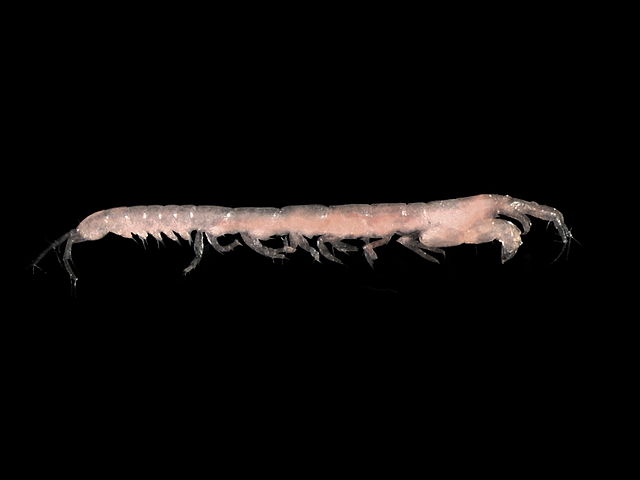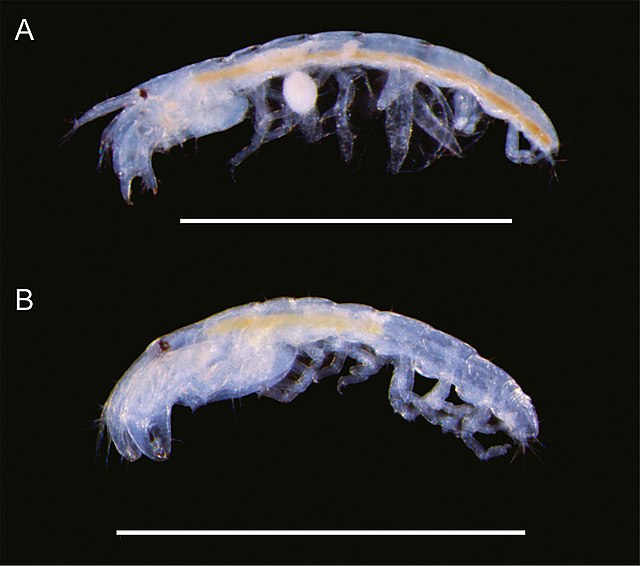Cover image credit to Segadilha JL, Serejo CS
Last week marked the release of a new paper co-authored by one member of the Invertomics group, James Fleming! The research presented in “Comprehensive transcriptome sequencing of Tanaidacea with proteomic evidences for their silk” was done whilst James was a JSPS postdoctoral fellow in Japan, as part of a collaboration led by Keiichi Kakui at Hokkaido University, alongside Masaru Mori and Kazuharu Arakawa (also from Keio) and Yoshihiro Fujiwara (from the Japan Agency for Marine-Earth Science and Technology).
This research focused on a little known group of shrimp-like crustaceans, known as Tanaids (pictured, credit to Hans Hillewaert). Though many arthropods – members of the group that includes crustaceans, insects, centipedes, millipedes, spiders and scorpions – produce silk, Tanaids are peculiar in that they also live in the ocean. There, they spin ‘Tubes’ of silk for shelter and safety, anchoring their homes to rocks, seaweed and sometimes even manatees! As such, understanding how they produce their silk, and what unique features their silk has that allows it to stay intact in saltwater has not only the potential to improve our understanding of the biological world around us, but also improve our own understanding of materials when trying to create new, more environmentally friendly water-resistant fabrics for use by humans.

The Tanaids are quite a diverse group when it comes to their living habits, though some live on the sea floor, others burrow deep underneath it. Even the depths at which they live can vary, with some being found near the coast, and others in the deepest parts of the ocean. We first sampled 23 different species of Tanaids from across the 4 different families of the group – the largest molecular dataset of the group ever made. By taking their transcriptomes – molecular records of the genes that are currently being transcribed (in use) – we were able to obtain a broad picture of what Tanaid silk looks like, and could deduce whether the material properties of their silk were affected by where and how they live.
For my part, I used the new transcriptomes to build a phylogeny – a tree of relationships – of the Tanaidacea, so that we could work out how the different groups were related, and if the different modes of life within that group (living on the sea floor, living in burrows under it, etc) were connected to the different families of Tanaids. That would then allow us to see whether any changes we saw in the silk proteins were affected by the ancestry of each species, or whether any adaptations had occurred independently.
Meanwhile, others within the collaboration undertook the painstaking task of analysing the silk of the group. They used microscopes to observe how the different silks looked under different levels of magnification to pick out similarities and differences between them. Following this, a protein analysis let us find which proteins made up Tanaid silk, which we followed with an analysis of the transcriptomes to determine how different Tanaid silks were on a biological level – both from known silks in other arthropods, and from the other Tanaid silks we were studying.
We found two protein families of Tanaid silk, that both seemed to be shared across the group! One was very similar to the silk proteins found in silkworms, but the other was more similar to the silk made by caddisworms. Even more interestingly, we found that though these proteins were structurally and superficially similar, they had a lot of unique features – they look like they evolved independently, rather than sharing an ancestor with silkworm or caddisworm silk. We might expect these results – the ancestor that all three of those groups share likely lived over 500 million years ago, and didn’t resemble any of them – but it does tell us that all these silk-weaving groups are falling back to similar answers to solve the same problem.
Different groups of Tanaids also spin their silk out of different glands on their body. We found that this seemed to relate to how sturdy the tubes were – with some glands producing sturdier silk than others. In addition, it seems like there are different silk protein blends being produced between these different groups, which shows that the glands the silk is produced by might also indicate the physical properties of the silk.
Learning more about Tanaid silk might help us produce biodegradable, water-resistant and environmentally friendly materials in the future. Clothes using synthetic spider silks are already available, and broader applications in medicine and construction are a hot topic. The unique properties of Tanaid silk might have broad applications in the future, and we are just now taking our first steps in understanding the possibilities of a world informed by these delightful marine crustaceans and their incredible tubes.
![]()
